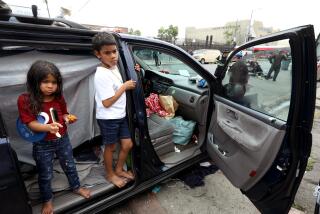L.A. Students May Fill Up Santa Monica’s Empty Classes
- Share via
As many as 1,000 students from overcrowded schools in Los Angeles could cross district boundaries to attend under-enrolled schools in Santa Monica and Malibu if a plan being considered by officials in both districts is approved.
Los Angeles School board member Alan Gershman said Tuesday that his board has authorized its staff to “have serious discussions” with Santa Monica and any other district seeking to fill empty classroom seats with students from overcrowded schools in Los Angeles.
Gershman and Santa Monica-Malibu board member Robert Holbrook met informally last month to discuss the proposal that they say could benefit both districts.
Holbrook reported the discussion to the board, which directed Santa Monica-Malibu Supt. George Caldwell to arrange talks with school officials in Los Angeles, Caldwell said.
The adjoining Los Angeles and the Santa Monica-Malibu Unified School districts face opposite enrollment problems.
In Los Angeles, school officials have been under pressure to provide seats for an estimated 82,000 additional students by 1990. Los Angeles already has 92 schools on year-round schedules and more are slated to adopt the controversial policy in the future.
In the Santa Monica-Malibu district, the opposite has occurred. The high price of housing has driven student enrollment down by more than a third, from 14,000 in 1977 to 9,600 in 1986. School officials estimate that the decline of enrollment is responsible for a $1.7-million deficit in the district’s $30-million 1986-87 budget.
‘It’s Eating Us Up’
“Our enrollment is declining evenly across our district so that even after we closed schools the problem has not been solved,” Holbrook said. “We are drowning in declining enrollment; it’s eating us up.”
At the same time, at many Los Angeles schools there are more students than the district can handle. Many students are bused from schools with a high percentage of minority students to schools with space.
“It’s almost a crime for students to be bused to far off neighborhoods when there is room just a mile away,” Holbrook said. “We are just a 12-minute freeway ride from some of their most overcrowded schools.”
He said that the Santa Monica-Malibu district needs at least 1,000 additional students to turn around the anticipated $1.7-million deficit the district expects to have next year and to offset the loss of nearly 500 students this year and the expected loss of another 500 next year.
“We can take 1,000 students from Los Angeles and not even be pinched,” he said. “One thousand students will provide provide significant relief to Santa Monica, but little to Los Angeles.” Holbrook said the plan could start in September.
Gershman said that much depends on the “delicate negotiations” needed to set up a student transfer program. He said that the districts must determine whether the students who transfer will be considered Los Angeles or Santa Monica students.
“Does Santa Monica collect (state revenues) for the students or do we keep the money and lease classroom space from them?” he asked. “It all has to be determined.”
Potential Problem
Another potential problem could result from the effect a large influx of minority students could have on the Santa Monica-Malibu district’s racial balance. Forty percent of the Santa Monica-Malibu’s student population is minority. Eighty-one percent of the Los Angeles student population is minority.
“I think it’s something we ought to explore,” said Santa Monica-Malibu school board president Richard Williams. “But I would hope that they would send a cross-section of kids that would match the (ethnic) balance we have.”
Santa Monica-Malibu school board member Peggy Lyons said she did not believe the Los Angeles district would send many white students because it would jeopardize its own desegregation program. Therefore, she said, “we have to determine what impact this will have on our own racial balance. If we bring in 1,000 students, that is a tenth of our population and it will have an impact,” she said.
Much of the decline in Santa Monica-Malibu’s enrollment has been traced to the high cost of housing in the district. District officials estimate that enrollment will continue to drop until it reaches about 7,500.
The enrollment decline has led to the closing of four schools, the reduction in its teaching staff and other drastic cost-cutting measures. However, the district still suffers because many of its fixed operating costs remain high, such as cafeteria services, utilities and even clerical expenses.
“We can’t reduce our costs as quickly as the enrollment declines,” said Sharon Hoaglund, the district’s financial administrator.
More to Read
Sign up for Essential California
The most important California stories and recommendations in your inbox every morning.
You may occasionally receive promotional content from the Los Angeles Times.













